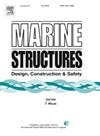An ULS reliability-based design method for mooring lines using an efficient full long-term approach
IF 4
2区 工程技术
Q1 ENGINEERING, CIVIL
引用次数: 0
Abstract
In the long-term scenario, the environmental actions to which floating offshore structures are subjected to, such as waves, wind and current, are non-stationary stochastic processes. However, this long-term behavior is usually modeled as a series of short-term stationary conditions. In a full long-term analysis approach, an estimate of the N-year response can be obtained through a multi-dimensional integration over expected short-term environmental conditions. An innovative and more efficient long-term integration approach based on the Importance Sampling Monte Carlo Simulation (ISMCS) method is presented, where the uniform distribution over an environmental contour is used as the sampling function. In parallel, a multi-dimensional joint environmental model that statistically describes all relevant environmental parameters is employed, contemplating linear and directional variables, and thoroughly accounting for the occurrences of wind waves and swell. The methodology is applied to two FPSOs systems installed in Brazilian ultradeep waters. Ultimately, a design-oriented procedure based on the developed methodologies is provided, using an Ultimate Limit State (ULS) reliability-based design with calibrated safety factors in an LRFD (Load and Resistance Factors Design) format. It is shown that the developed procedures can be powerful tools to account for the simultaneous occurrence of wind sea and swell waves in offshore system response evaluations required in the design and life extension analyses.
基于 ULS 可靠性的系泊缆线设计方法,采用高效的全长期方法
在长期情况下,海上浮动结构所受到的环境影响,如海浪、风和水流,都是非静态的随机过程。然而,这种长期行为通常被模拟为一系列短期静态条件。在完整的长期分析方法中,可以通过对预期的短期环境条件进行多维整合来获得 N 年响应的估计值。本文提出了一种基于重要度抽样蒙特卡洛模拟(ISMCS)方法的创新型、更高效的长期积分方法,即使用环境等值线上的均匀分布作为抽样函数。同时,还采用了一个多维联合环境模型,该模型可统计描述所有相关环境参数,考虑线性和方向变量,并全面考虑风浪和涌浪的发生。该方法适用于安装在巴西超深水域的两个 FPSO 系统。最后,在所开发方法的基础上提供了一个以设计为导向的程序,该程序采用基于极限状态(ULS)的可靠性设计,并以 LRFD(载荷和阻力系数设计)格式校准了安全系数。结果表明,所开发的程序是一种强大的工具,可以在设计和延寿分析所需的近海系统响应评估中考虑到同时出现的风浪和涌浪。
本文章由计算机程序翻译,如有差异,请以英文原文为准。
求助全文
约1分钟内获得全文
求助全文
来源期刊

Marine Structures
工程技术-工程:海洋
CiteScore
8.70
自引率
7.70%
发文量
157
审稿时长
6.4 months
期刊介绍:
This journal aims to provide a medium for presentation and discussion of the latest developments in research, design, fabrication and in-service experience relating to marine structures, i.e., all structures of steel, concrete, light alloy or composite construction having an interface with the sea, including ships, fixed and mobile offshore platforms, submarine and submersibles, pipelines, subsea systems for shallow and deep ocean operations and coastal structures such as piers.
 求助内容:
求助内容: 应助结果提醒方式:
应助结果提醒方式:


